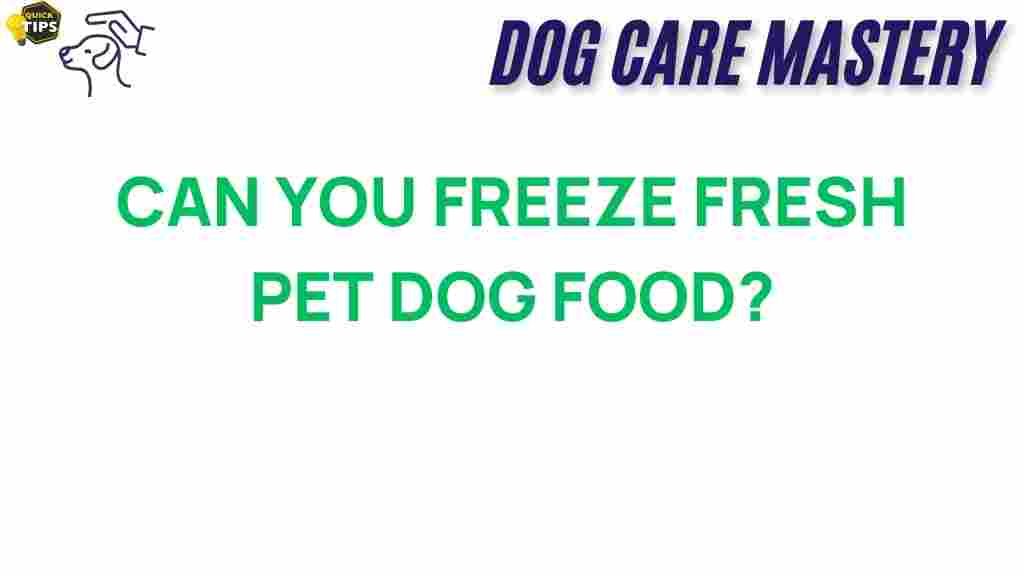Unlocking the Secrets: Can You Safely Freeze Fresh Pet Dog Food?


Unlocking the Secrets: Can You Safely Freeze Dog Food?
As pet owners, we always strive to provide the best for our furry companions. Fresh dog food has gained popularity for its nutritional benefits, but many wonder if they can safely freeze dog food to extend its shelf life. The good news is that yes, you can! This article will explore how to properly freeze dog food, the benefits of doing so, and tips to ensure your pet’s meals remain safe and nutritious.
Why Freeze Dog Food?
Freezing dog food can be an excellent way to:
- Extend the shelf life of fresh dog food.
- Reduce waste by preserving leftovers.
- Ensure that you always have a nutritious meal on hand.
- Save money by buying in bulk.
With the right techniques, you can maintain the quality and nutrition of your dog’s food while enjoying these benefits.
How to Freeze Dog Food Safely
To safely freeze dog food, follow these steps:
Step 1: Choose the Right Containers
Use airtight containers or freezer bags to prevent freezer burn and preserve freshness. Make sure they are specifically designed for freezing food. Here are some excellent options:
- Plastic freezer bags
- Glass containers with airtight lids
- Silicone food storage containers
Step 2: Portion the Food
Before freezing, divide the dog food into meal-sized portions. This makes it easier to thaw only what you need without refreezing any leftovers. Consider using:
- Ice cube trays for small portions
- Meal prep containers for larger servings
Step 3: Label and Date
Always label your containers or bags with the contents and the date of freezing. This helps you keep track of how long the food has been frozen. Dog food can generally be frozen for up to six months, but it’s best consumed within three months for optimal freshness.
Step 4: Freeze the Food
Place the containers or bags in the coldest part of your freezer. Make sure they are laid flat so that they freeze evenly. Avoid overcrowding the freezer to ensure proper air circulation.
Step 5: Thawing the Food
When you’re ready to serve the frozen dog food, thaw it in the refrigerator overnight. If you’re short on time, you can also use the microwave, but be cautious to avoid hot spots that could burn your pet’s mouth. Always check the temperature before serving.
Common Questions About Freezing Dog Food
Here are some frequently asked questions about freezing dog food:
Can you freeze homemade dog food?
Yes, homemade dog food can be frozen just like commercial dog food. Ensure it is well-prepared and stored in airtight containers.
Can you refreeze dog food?
Avoid refreezing thawed dog food. Once food has been thawed, it should be used within a few days. Refreezing can compromise the quality and safety of the food.
Does freezing affect the nutritional value of dog food?
Freezing dog food does not significantly affect its nutritional value, especially if done correctly. However, be mindful that over time, some nutrients may degrade.
Troubleshooting Tips
If you encounter issues when freezing dog food, consider the following tips:
- Freezer Burn: If you notice ice crystals or discolored patches, the food may have freezer burn. Ensure containers are airtight before freezing.
- Off Odor: If the food smells strange after thawing, discard it. This could indicate spoilage.
- Texture Changes: Some dog foods may change texture after freezing. If your dog seems hesitant to eat it, try mixing it with fresh food to encourage them.
What Types of Dog Food Can Be Frozen?
Most types of dog food can be frozen, including:
- Dry kibble
- Wet food in cans or pouches
- Homemade meals
- Raw diets
However, always check with your vet before freezing specialized diets or food containing specific ingredients that might not freeze well.
Best Practices for Freezing Dog Food
To maximize the benefits of freezing dog food, keep these best practices in mind:
- Always portion out meals before freezing.
- Keep your freezer at 0°F (-18°C) or lower for optimal preservation.
- Avoid leaving dog food at room temperature for too long after thawing.
- Consider investing in a vacuum sealer for longer-lasting storage.
Conclusion
Freezing dog food is a practical and effective way to ensure your pet always has access to fresh, nutritious meals. By following the steps outlined in this article, you can safely freeze dog food and extend its shelf life without compromising its quality. Remember to label your containers, portion meals, and adhere to best practices to keep your pet’s food safe and tasty. For more tips on pet care and nutrition, check out our comprehensive guide here.
For further information on dog food storage and safety, you can visit this resource.
Your dog deserves the best, and by mastering the art of freezing dog food, you’re taking a significant step towards ensuring their health and happiness!
This article is in the category Nutrition and created by dogcaremastery Team
Recent Posts
Expert Tips to Remove Dog Poop from Carpet Effortlessly
Discover expert tips for dog poop removal from carpet to keep your home clean and…
Discover the Best Food for Your Pregnant Dog’s Health
Explore what food to feed a pregnant dog to ensure optimal health for her and…
Is It Time for a Trim? Signs Your Dog’s Nails Need Attention
Discover how to tell if your dog's nails need trimming and ensure their comfort and…
Unlocking the Secret: How to Stop a Dog from Chewing Everything
Discover effective ways to stop dog chewing and protect your belongings with expert training tips…
When Should You Be Concerned About Your Dog’s Hydration Levels?
Discover when dog hydration becomes a concern and the signs of dehydration you shouldn't ignore.
Can Cats Safely Snack on Dog Food? The Surprising Truth Revealed
Is it safe for your cat to eat dog food? Discover the truth about cat…